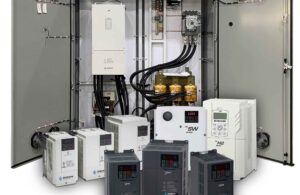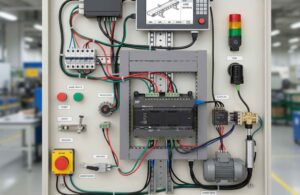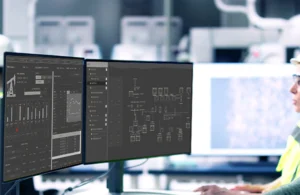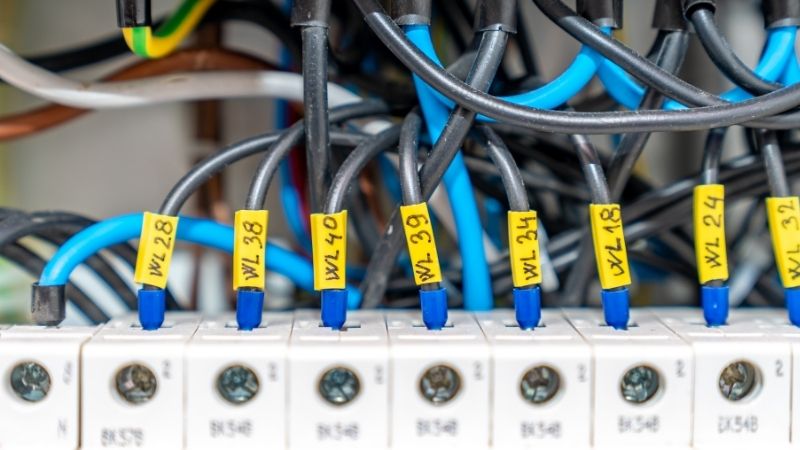PLC kimenettípusok: Alapvető útmutató automatizálási mérnökök számára
Akár tapasztalt automatizálási szakember, akár csak most kezdi az utat, ez a cikk értékes betekintést nyújt a PLC kimeneti technológiák.
Tartalomjegyzék
Melyek a PLC kimenetek fő típusai és hogyan működnek?
A PLC-kimenetek többféle változatban kaphatók, mindegyiket speciális alkalmazásokhoz és követelményekhez tervezték. A három fő típus a következő:
- Relé kimenetek: Hagyományos elektromechanikus kapcsolókészülékek
- Tranzisztor kimenetek: Szilárdtest kapcsolás DC alkalmazásokhoz
- Triac kimenetek: Szilárdtest kapcsolás váltakozó áramú alkalmazásokhoz
A relé kimenetek a legsokoldalúbbak, mivel AC és DC terhelést is képesek kezelni. Egy tipikus relé kimeneti modul fizikai tekercseket és reléérintkezőket tartalmaz, amelyeket a relé tekercsre feszültség kapcsolásával működtetnek. Például a Allen-Bradley Az 1756-OW16I 16 egyedi relé kimenettel rendelkezik, így alkalmas különféle ipari alkalmazásokra.
Melyek a legfontosabb különbségek a félvezetős és a relé kimenetek között?
A szilárdtest- és relé kimenetek közötti választás több tényezőtől függ:
| Funkció | Szilárdtest-kimenetek | Relé kimenetek |
|---|---|---|
| Kapcsolási sebesség | Gyors (mikroszekundum) | Lassú (ezredmásodperc) |
| Élettartam | Hosszú (mozgó alkatrészek nélkül) | Korlátozott (mechanikai kopás) |
| Feszültség tartomány | AC vagy egyenáramra korlátozva | AC és DC egyaránt |
| Költség | Magasabb kezdeti költség | Alacsonyabb kezdeti költség |
| Karbantartás | Minimális | Rendszeres karbantartás szükséges |
A relékimenetek egyik előnye a feszültségfüggetlenségük, amely lehetővé teszi, hogy AC és DC terhelést is váltsanak anélkül, hogy külön modulra lenne szükségük. A szilárdtest-készülékek azonban jobb megbízhatóságot és hosszabb élettartamot kínálnak a mozgó alkatrészek hiánya miatt.
Hogyan kapcsolódnak a digitális kimeneti modulok az ipari berendezésekhez?
A digitális kimeneti modulok interfészként szolgálnak a PLC program és a külső eszközök között. Ezek a modulok vezérelhetik:
- Motorindítók
- Mágnesszelepek
- Jelző lámpák
- Kontaktorok
- Egyéb digitális vagy diszkrét eszközök
A kimeneti modul a PLC program által hozott döntések alapján működik, és ezeket a döntéseket feszültség- vagy áramjeleken keresztül fizikai cselekvésekké alakítja. Például használhat egy kimenetet váltóáramú terhelés kezelésére, egy másik kimenetet pedig egyenáramú terhelés vezérlésére, rugalmas szabályozási lehetőségeket biztosítva.
Mik a fontos szempontok a PLC kimenet kiválasztásánál?
A PLC kimenetek kiválasztásakor vegye figyelembe az alábbi döntő tényezőket:
- Névleges feszültség és áram
- Üzemi feszültség követelményei
- Maximális áramfelvétel
- Túlfeszültség-védelmi igények
- Kapcsolási követelmények
- A váltás gyakorisága
- Terhelés típusa (rezisztív, induktív, kapacitív)
- Válaszidő követelményei
- Környezeti feltételek
- Üzemi hőmérséklet
- Páratartalom szintje
- Elektromos zaj
Melyek a PLC-kimenetekkel kapcsolatos gyakori hibaelhárítási problémák?
A gyakori kimeneti problémák megértése segít fenntartani a rendszer megbízhatóságát:
- A kimenetek rövidzárlat elleni védelme
- A feszültség nagy távolságokon esik le
- A közeli berendezések által okozott interferencia
- Kimeneti modul meghibásodási tünetei
- Megfelelő földelési technikák
Gyakran Ismételt Kérdések
A PLC kimeneti modul a program döntéseit fizikai műveletekké alakítja azáltal, hogy külső eszközöket elektromos jelekkel vezérel.
A választás a terhelési követelményektől és a rendszer kialakításától függ. Az elsüllyedő kimenetek általánosak Észak-Amerikában, míg Európában a beszerzési kimenetek.
A tranzisztoros kimenetek nagyobb kapcsolási sebességet, hosszabb élettartamot és mechanikai kopásmentességet kínálnak, így ideálisak nagy sebességű alkalmazásokhoz.
A relékimenetek előnyben részesíthetők, ha feszültségrugalmasságra van szükség, vagy ha teljes elektromos leválasztásra van szükség a vezérlő és a terhelési áramkörök között.
Használjon megfelelő túlfeszültség-védelmet, gondoskodjon a megfelelő vezetékezésről, tartsa be a megfelelő terhelési értéket, és hajtson végre megfelelő hűtési intézkedéseket.
Erősítse meg projektjeit vadonatúj, eredeti Omron, Mitsubishi, Schneider PLC segítségével – raktáron, készen áll!
Következtetés
- A PLC kimeneteknek három fő típusa van: relé, tranzisztor és triac
- Minden kimeneti típusnak sajátos előnyei és alkalmazásai vannak
- A megfelelő kiválasztás a terhelési követelményektől és a környezeti feltételektől függ
- A rendszeres karbantartás és ellenőrzés biztosítja a megbízható működést
- A védelmi intézkedések elengedhetetlenek a hosszú távú megbízhatósághoz
Új, eredeti PLC-ket keres projektjeihez? A Kwoco-nál a legfrissebb PLC-ket kínáljuk olyan legnépszerűbb márkáktól, mint például Omron, Mitsubishi, és Schneider. Vásároljon bizalommal – gyors szállítás, garantált minőség! Vásároljon most
Lépjen kapcsolatba velünk
Csak töltse ki nevét, e-mail címét és kérésének rövid leírását ezen az űrlapon. 24 órán belül felvesszük Önnel a kapcsolatot.
Ezeket a témákat is érdekesnek találhatja

Kondenzátorreform: Keltse életre VFD-jét tárolás után
Ez a cikk a tárolóban lévő VFD-k (Variable Frequency Drives) kondenzátor-reformálásának kritikus folyamatát mutatja be. Ha Ön a gépeket és berendezéseket gyártó iparban dolgozik, vagy gyári megoldásokat kínál, ennek a folyamatnak a megértése döntő fontosságú az állásidő megelőzése és a berendezése hosszú élettartamának biztosítása érdekében. Megvizsgáljuk, miért van szükség a kondenzátorok átalakítására, hogyan működik, és milyen lépéseket tehet a VFD-k védelme érdekében.

Átfogó útmutató a PLC típusokhoz és főbb jellemzőkhöz
A programozható logikai vezérlők (PLC-k) valójában az ipari automatizálás alapjává váltak, megbízhatóságot, sokoldalúságot és hatékonyságot kínálva a vezérlőrendszerekben. Ez a rövid cikk ismerteti a PLC-k alapjait, osztályozásukat, előnyeiket és a jövőbeli fejlesztési trendeket.

Hogyan kommunikálnak hatékonyan a PLC és a SCADA rendszerek
Hogyan biztosítják a gyárak az összes berendezés szinkronizálását, az adatok zökkenőmentes áramlását és a hatékonyság maximalizálását? Itt működik együtt a PLC és a SCADA.






